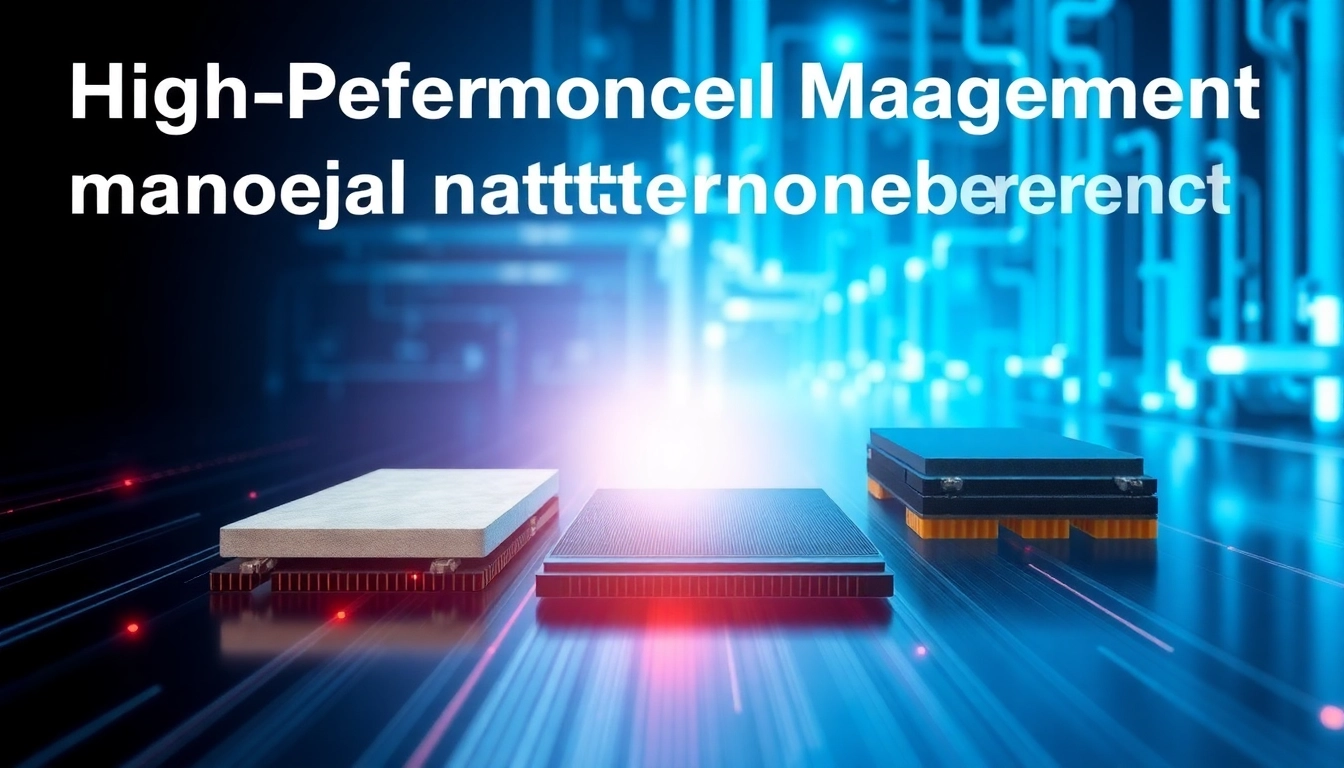
Understanding Thermal Management Materials
As electronic devices continue to evolve in complexity and performance, the need for effective heat dissipation has become crucial. This is where thermal management materials play a significant role. They are specially designed materials that aid in controlling and dissipating heat generated by electronic components. Proper thermal management not only enhances device performance but also extends their lifespan, making these materials essential in various industrial and commercial applications.
Definition and Importance of Thermal Management
Thermal management pertains to the techniques, materials, and methodologies used to control the temperature of electronic components in order to maintain optimal performance and reliability. Rising temperatures can lead to reduced efficiency, failure, and shorter device lifetimes. By effectively managing heat, these materials contribute to the overall durability and functionality of electronics. In an age where device miniaturization is prevalent, ensuring adequate thermal management has never been more vital.
Common Types of Thermal Management Materials
Several categories of thermal management materials exist, each designed for specific applications and environments. These include thermal interface materials (TIMs), gap pads, thermal adhesives, phase change materials (PCMs), and thermal tapes, among others. Understanding these types and their unique properties allows engineers to select the most suitable solutions for their specific needs.
Applications in Electronic Devices
Thermal management materials are used across various sectors, from consumer electronics to automotive and aerospace industries. They are integral in applications like computer chips, LED lights, power semiconductors, and more. Efficient thermal management directly translates into improved performance and reduced risks of failure in these devices. For instance, in high-performance computing, the use of proper thermal management materials ensures that processors operate within safe temperature limits while maximizing computational power.
Types of Thermal Management Materials
Thermal Interface Materials (TIM)
Thermal Interface Materials (TIMs) are crucial for filling microscopic air gaps between heat-generating components and heat sinks or spreaders. By enhancing thermal conductivity, TIMs facilitate better heat transfer, thus improving cooling efficiency. Common types include thermal pastes, greases, and pads. Each type has its unique properties, such as thermal conductivity, viscosity, and application method, which affect overall performance.
Gap Pads and Thermal Tapes
Gap pads are soft, conformable materials designed to fill gaps between electronic parts. They provide good thermal conduction and electrical insulation. Thermal tapes, on the other hand, are pressure-sensitive adhesives that can bond components while providing a necessary thermal pathway. The usability of these materials depends largely on their thermal resistance, compressibility, and adhesive strength.
Phase Change Materials (PCMs)
Phase Change Materials (PCMs) are unique in that they absorb and release thermal energy during phase transitions, typically between solid and liquid states. This characteristic allows them to maintain specific temperatures for extended periods, making them ideal for thermal regulation in applications like battery storage, LED assemblies, and high-performance processors. Understanding the melting point and thermal efficiency of PCMs helps in selecting the right material for specific applications.
Choosing the Right Thermal Management Material
Performance Metrics to Consider
When selecting thermal management materials, several performance metrics must be evaluated. Thermal conductivity is paramount, indicating how effectively heat can be transferred. Additionally, factors such as thermal resistance, operating temperature range, and mechanical compliance should be considered, as they affect the effectiveness of the material in real-world applications.
Compatibility with Electronic Components
It is essential to ensure that thermal management materials are compatible with the electronic components they will be used with. This includes evaluating chemical interactions, electrical insulation properties, and the ability to withstand physical stress. Proper compatibility enhances not only performance but also safety, preventing damage to components during operation.
Cost vs. Efficiency Analysis
While high-performing thermal management materials can be more expensive, it’s vital to balance cost and efficiency. Reliable data should be collected to analyze the potential long-term savings derived from using superior materials versus the initial investment. This analysis often involves evaluating performance metrics like longevity, energy efficiency, and potential cost of failures due to inadequate cooling solutions.
Best Practices for Implementation
Installation Techniques for Effective Results
Proper installation techniques greatly influence the effectiveness of thermal management materials. For instance, ensuring that surfaces being bonded are clean and free of contaminants is crucial for TIM applications. Techniques such as applying appropriate amounts of TIM and using the correct pressure can maximize thermal contact and improve heat dissipation. Knowing when to apply thermal adhesive or tape versus a gap pad is essential for optimizing thermal pathways.
Maintenance Tips for Longevity
To maintain the effectiveness of thermal management materials, regular inspection and maintenance are key. Engineers should monitor temperature fluctuations during use, as consistent overheating can degrade materials over time. Additionally, training personnel on the proper handling and installation techniques can ensure prolonged performance and reliability.
Common Mistakes to Avoid
Mistakes during the selection and application of thermal management materials can lead to significant performance issues. Common errors include using inadequate amounts of TIM, failing to align materials properly, or overlooking the specific operating conditions. Awareness of these pitfalls allows manufacturers and engineers to avert costly failures and enhance product reliability.
The Future of Thermal Management Materials
Innovations in Thermal Management Technology
The landscape of thermal management materials is rapidly evolving, with innovations emerging to meet the demands of modern electronics. Advanced materials such as graphene, nanocomposites, and highly efficient metal-based TIMs are becoming more prevalent. Research into high-performance polymers and eco-friendly alternatives is also gaining traction, expanding the possibilities for energy efficiency and recyclability.
Sustainability Trends in Material Development
As sustainability becomes a key focus in the manufacturing landscape, thermal management materials are also seeing improvements in environmental friendliness. The development of bio-based materials and recyclable products is on the rise, along with an increased emphasis on reducing waste in the production process. Engineers and manufacturers need to consider the life cycle of materials, from sourcing to disposal, to align with sustainability goals.
Predictions for Industry Evolutions
Looking ahead, the demand for efficient thermal management solutions will continue to surge, especially with advancements in technologies like electric vehicles, renewable energy systems, and high-performance computing. The industry is likely to see enhanced collaboration between material scientists and engineers to innovate solutions that effectively address ongoing thermal challenges. Furthermore, as regulations concerning energy efficiency progress, companies that embrace advanced thermal management practices will gain a competitive edge.








